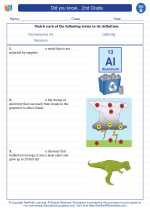Nervous System
The nervous system is a complex network of nerves and cells that transmit signals between different parts of the body. It is responsible for coordinating and controlling the body's activities, including movement, sensation, and thought.
Parts of the Nervous System
The nervous system is divided into two main parts: the central nervous system (CNS) and the peripheral nervous system (PNS).
Central Nervous System (CNS)
- The CNS includes the brain and spinal cord.
- It processes and interprets sensory information and sends out instructions based on this information.
Peripheral Nervous System (PNS)
- The PNS consists of all the nerves outside of the CNS.
- It connects the CNS to the rest of the body and transmits signals to and from the CNS.
Functions of the Nervous System
The nervous system has three main functions:
- Sensory Function: The nervous system receives information from the body's internal and external environment through sensory receptors.
- Integrative Function: It processes and interprets the sensory information to determine an appropriate response.
- Motor Function: The nervous system sends signals to muscles, glands, and organs to initiate a response based on the sensory information.
Study Guide
Here are some key points to remember when studying the nervous system:
- What are the two main parts of the nervous system? Describe their functions.
- Explain the role of the central nervous system and the peripheral nervous system.
- What are the three main functions of the nervous system? Provide examples of each function.
- Identify the components of the nervous system and their functions.
- Describe the pathways through which signals travel within the nervous system.
Remember to review the structure and functions of the nervous system to gain a comprehensive understanding of this important bodily system.
.◂Science Worksheets and Study Guides Second Grade. Did you know... 2nd Grade
Study Guide Did you know... 2nd Grade
Did you know... 2nd Grade  Worksheet/Answer key
Worksheet/Answer key Did you know... 2nd Grade
Did you know... 2nd Grade  Worksheet/Answer key
Worksheet/Answer key Did you know... 2nd Grade
Did you know... 2nd Grade  Worksheet/Answer key
Worksheet/Answer key Did you know... 2nd Grade
Did you know... 2nd Grade  Vocabulary/Answer key
Vocabulary/Answer key Did you know... 2nd Grade
Did you know... 2nd Grade 

 Worksheet/Answer key
Worksheet/Answer key
 Worksheet/Answer key
Worksheet/Answer key
 Worksheet/Answer key
Worksheet/Answer key
 Vocabulary/Answer key
Vocabulary/Answer key

The resources above cover the following skills:
Earth Systems Science
Weather and the changing seasons impact the environment and organisms such as humans, plants, and other animals. Students can:
Analyze ways in which severe weather contributes to catastrophic events such as floods and forest fires